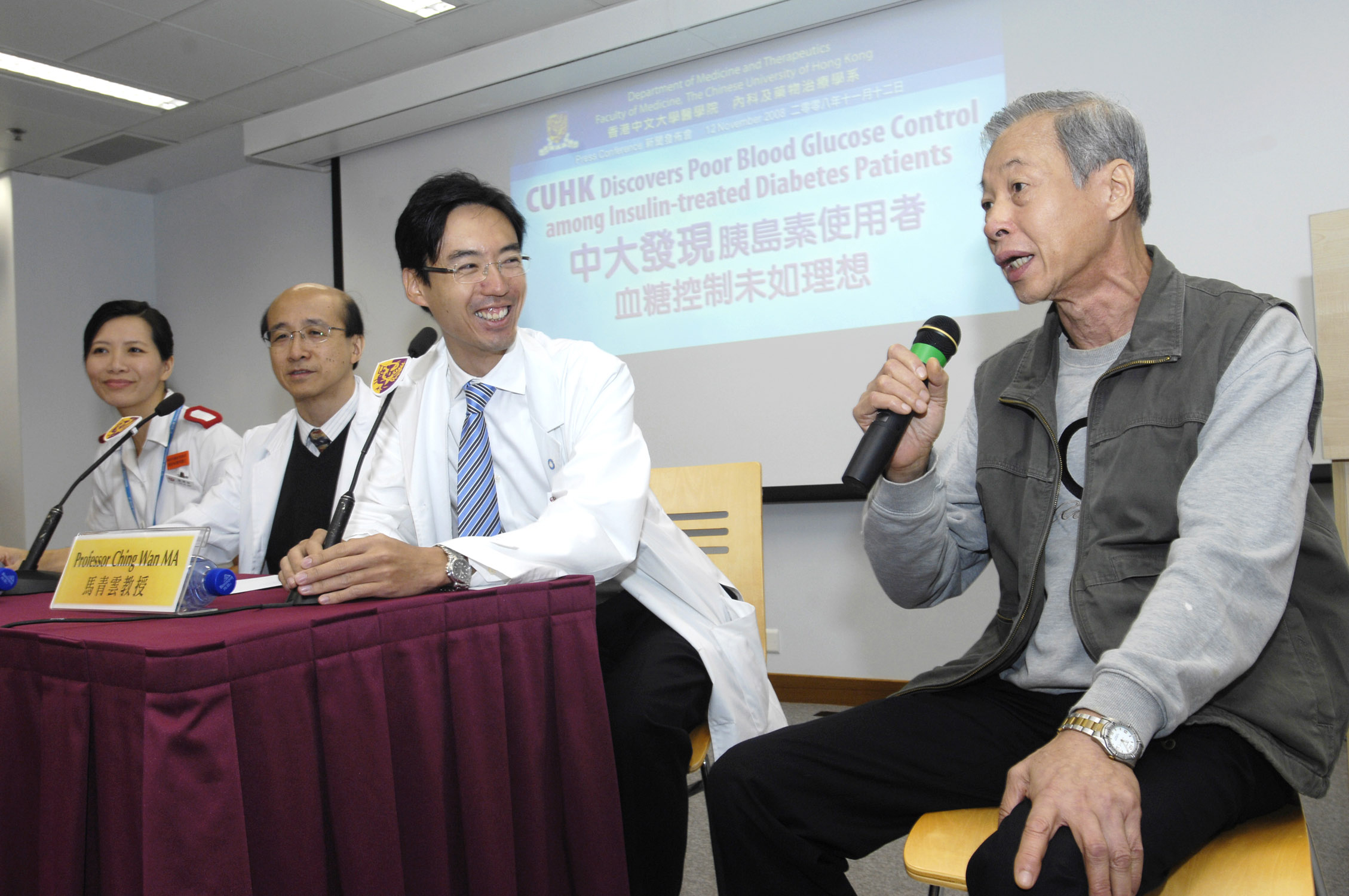CUHK
News Centre
CUHK Discovers Poor Blood Glucose Controlamong Insulin-treated Diabetes Patients
According to the estimation by World Health Organization, there are 700,000 diabetes patients in Hong Kong and about 20% of them are insulin users. A recent study by the Department of Medicine and Therapeutics at The Chinese University of Hong Kong (CUHK) has found that despite the use of insulin, most patients do not achieve optimal glycemic control. Their blood glucose levels show great fluctuation and for most of the time do not reach the recommended target, putting themselves at risk of diabetic complications.
14 November was chosen as the date for World Diabetes Day in order to commemorate Dr Frederick Banting who discovered insulin. Insulin is an effective treatment for patients with diabetes and early insulinization is recommended by The American Diabetes Association (ADA) and The European Association for the Study of Diabetes (EASD). However, insulinization rate still remains low in Hong Kong. Even those who are on insulin treatment often do not achieve the target of HbA1c < 7% and sometimes suffer from episodes of low blood glucose.
In order to investigate the reasons for suboptimal glucose control among insulin-treated patients with diabetes, CUHK researchers have studied 58 patients with poorly controlled diabetes despite the use of insulin treatment. All patients underwent continuous monitoring of their blood glucose levels over 72 hours. Results showed that:
1. Patients’ HbA1c averaged at 8.3% (higher than the 7% target recommended by ADA and EASD);
2. Their blood glucose levels were above 8 mmol/L for almost 60% of the time;
3. Despite having poorly controlled diabetes, nearly two-third of the subjects had low readings of blood glucose of less than 4 mmol/L (hypoglycemia events are common);
4. Most patients had large fluctuation in blood glucose levels, with 22.2 mmol/L at m aximum to 1.2 mmol/L at minimum;
5. On average, blood glucose levels were within normal range (between 4 and 8mmol/L) for only 34% of the time.
Moreover, when patients were divided into three groups according to the duration that blood glucose was maintained between 4 and 8mmol/L, it was found that those patients who spend the least time within the desired range also have the greatest fluctuation in blood glucose levels, and have the worst long-term control as reflected by higher HbA1c, a marker of diabetes control which predicts the risk of future complications.
Chief investigator of the study, Professor Ronald Ma, Associate Professor of the Department of Medicine and Therapeutics at CUHK said, “The results so far have already reflected the poor control of diabetes among patients. Besides elevated blood glucose levels, the great glucose variation and the frequent episodes of hypoglycaemia also indicate that most patients are not receiving the optimal insulin treatment.”
Professor Peter Tong, Department of Medicine and Therapeutics at CUHK as well as specialist in diabetes and endocrinology, explained that an ideal blood glucose control means to maintain a steady level between 4 and 8 mmol/L at all time. Patients usually will not be alerted when their blood glucose level is slightly above the normal range. However, a prolonged elevated blood glucose level will eventually lead to devastating diabetic complications. That is why lowering blood glucose to the desired level is very important. On the other hand, when blood glucose level drops too low, patients will suffer from episodes of hypoglycaemia such as feelings of fatigue, hunger, palpitation, sweating, irritability, blurred vision and may even fall into coma. Professor Tong said, “Patients with experiences of these symptoms are usually frightened. Hence, they tend to keep the blood sugar at high levels, and with time, these patients will develop devastating vascular complications of diabetes.”
Mr. Kwan, a 70-year-old type 2 diabetes patient treated with insulin, showed poor diabetes control previously on twice daily injections of insulin. He had episodes of hypoglycaemia as well as frequent elevated readings, with elevated HbA1c of 9.1%. He was recruited into the research study. Monitoring of his blood glucose over 72 hours revealed that he had marked fluctuation in blood glucose, and in particular, his blood glucose was elevated (more than 8mmol/L) for 82% of the monitored period. After reviewing his glucose profile, he was changed to a regime of 3 daily injections of short acting insulin before meals, and a once-daily basal insulin analogue given at bedtime. After 3 months, a repeat 72 hours monitoring revealed a marked reduction in his blood glucose variation, with improvement of overall glucose control and remarkable reduction in HbA1c to 6.8%.
Professor Ma said such a case with marked fluctuation in blood glucose is actually very common. Patients can hardly notice the fluctuation if they never have an episode of low blood glucose. By monitoring Mr. Kwan’s blood glucose level with the CGMS, his large glucose variation could be detected. The information enabled doctors to change his insulin treatment regime with a long acting and peakless insulin analogue and hence improved his blood glucose control and stability.
Professor Tong quoted the treatment consensus by the ADA and EASD issued last year, “Among different preparations of basal insulin, extra long acting insulin analogue can provide steady blood glucose control.”
In conclusion, the Department of Medicine and Therapeutics at CUHK stresses the importance of maintaining blood glucose stability. Patients with the least fluctuation and blood glucose within the normal range for the largest portion of time have the best control of their diabetes. Patients and doctors often only have a snapshot of the patient’s actual blood glucose profile during the consultation. More frequent home blood glucose monitoring by patients themselves may detect the peaks and troughs that are often neglected. Better information on the blood glucose profile of patients during the day may help doctors select the most appropriate insulin treatment regime for patients. The best regime should aim at good diabetes control with reduction in the risk of hypoglycemia.



